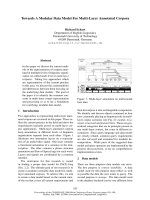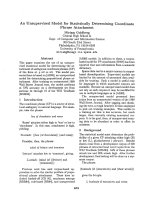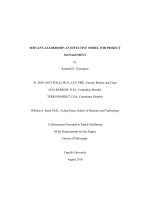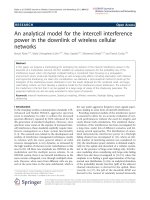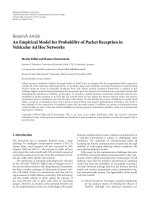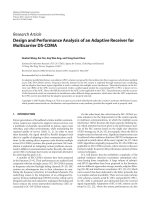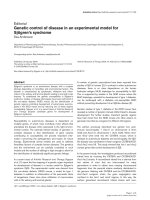An adaptive model for multi modal biometrics decision fusion
Bạn đang xem bản rút gọn của tài liệu. Xem và tải ngay bản đầy đủ của tài liệu tại đây (8.87 MB, 115 trang )
AN ADAPTIVE MODEL FOR MULTI-MODAL
BIOMETRICS DECISION FUSION
TRAN QUOC LONG
NATIONAL UNIVERSITY OF SINGAPORE
2005
AN ADAPTIVE MODEL FOR MULTI-MODAL
BIOMETRICS DECISION FUSION
TRAN QUOC LONG
(B.Sc, Vietnam National University)
A THESIS SUBMITTED FOR THE DEGREE OF
MASTER OF ENGINEERING
DEPARTMENT OF ELECTRICAL AND COMPUTER ENGINEERING
NATIONAL UNIVERSITY OF SINGAPORE
2005
Name: Tran Quoc Long
Degree: Master of Engineering
Department: Electrical and Computer Engineering
Title: An Adaptive Model for Multi-Modal Biometrics Decision Fusion
Abstract
Multi-modal biometric verification is gaining more and more attention recently because of the high security level it provides and the non-universality of uni-modal biometrics. Multi-modal biometrics decision fusion can be considered as a classification
task since the output is either a genuine user or an impostor. This treatment allows
many available classifiers to be applied in the field. In this thesis, two problems related to multi-modal biometrics decision fusion are considered. The first problem is
new user registration. Frequent registration not only requires storing of new patterns
into the biometric database but also requires updating the combination module efficiently. The second problem is related to sensor decay which results in change of
matching scores with time. The performance of a fixed classifier may be affected
for such case. In this thesis, an adaptive algorithm to solve these problems has been
proposed. This algorithm can update the combination module whenever new training
patterns are available without having to retrain the module from scratch. The new
algorithm is demonstrated using experiments on physical application data to address
both the registration and matching scores distribution changing problems using three
biometrics, namely fingerprint, speech and hand-geometry.
Keywords: Multi-modal biometrics, decision fusion, biometrics verification,
recursive least squares, parameter estimation.
ACKNOWLEDGMENTS
I would like to express my sincere gratitude to my advisors, Dr. Kar-Ann Toh and
professor Dipti Srinivasan, for their constant support, guidance and motivation. I take
this opportunity to thank the staff members in the Department of Electrical and Computer Engineering for helping me with the administrative details regarding my thesis. I
would also like to thank the Institute for Infocomm Research, Singapore for sponsoring
my research scholarship.
In addition, I would like to thank my friends at the institute, Pham Nam Trung,
Pham Duc Minh and Phung Minh Hoang, for many helpful discussions we had together and my roommates, Dinh Trung Hoang, Alin Chitu and Jonathan Stern, for
their advices on many stubborn problems in academics as well as in life.
I would also like to thank my parents, my brother and the rest of my family members for their endless support to all my endeavors. Finally, I would like to express my
deepest gratitude to Tran Thuy Anh for all the encouragement, support and fun she has
provided throughout my stay in Singapore.
i
Contents
Acknowledgements
Summary
1
2
i
vi
List of Figures
viii
List of Tables
ix
Introduction
1
1.1
Need for Biometric Verification . . . . . . . . . . . . . . . . . . . . .
2
1.2
General Concepts in Biometric Systems . . . . . . . . . . . . . . . .
4
1.2.1
Identification versus verification . . . . . . . . . . . . . . . .
4
1.2.2
Performance measures of a verification system . . . . . . . .
5
1.3
Overview of Uni-Modal Biometric Verification Systems . . . . . . . .
8
1.4
Overview of Multi-Modal Biometric Verification Systems . . . . . . .
10
1.4.1
Approaches to multi-modal biometric verification . . . . . . .
11
1.4.2
Multi-modal biometric verification as a classification problem
12
1.5
Motivation and Problem Statement . . . . . . . . . . . . . . . . . . .
13
1.6
Contributions of the Thesis . . . . . . . . . . . . . . . . . . . . . . .
14
1.7
Thesis Organization . . . . . . . . . . . . . . . . . . . . . . . . . . .
16
Literature Review
17
2.1
17
Uni-modal Biometric Verification . . . . . . . . . . . . . . . . . . .
ii
2.2
2.3
2.4
3
2.1.1
Fingerprint verification . . . . . . . . . . . . . . . . . . . . .
17
2.1.2
Speech (Voice) verification . . . . . . . . . . . . . . . . . . .
19
2.1.3
Hand-geometry verification . . . . . . . . . . . . . . . . . .
21
Multi-modal Biometric Verification . . . . . . . . . . . . . . . . . .
23
2.2.1
Different implementations in multi-modal biometric verification 23
2.2.2
Non-training based methods . . . . . . . . . . . . . . . . . .
25
2.2.3
Training based methods . . . . . . . . . . . . . . . . . . . .
26
Multi-modal Biometric Verification as a Classification Task: Related
Works . . . . . . . . . . . . . . . . . . . . . . . . . . . . . . . . . .
28
Summary . . . . . . . . . . . . . . . . . . . . . . . . . . . . . . . .
31
Evaluation of Classification Tools
32
3.1
Commonly Used Classification Tools . . . . . . . . . . . . . . . . . .
34
3.1.1
Support Vector Machines (SVM) . . . . . . . . . . . . . . . .
34
3.1.2
k-Nearest Neighbor classifier (kNN) . . . . . . . . . . . . . .
35
3.1.3
Multi-Layer Perceptron (MLP) . . . . . . . . . . . . . . . . .
36
3.1.4
Reduced Multivariate polynomials (RM) . . . . . . . . . . .
36
3.1.5
Hyperbolic function networks (SINH, COSH and TANH) . .
39
3.1.6
Ramp and step networks (RAMP and STEP) . . . . . . . . .
41
Experimental Setup . . . . . . . . . . . . . . . . . . . . . . . . . . .
42
3.2.1
The University of California at Irvine (UCI) data sets . . . . .
42
3.2.2
Performance criteria . . . . . . . . . . . . . . . . . . . . . .
42
3.2.3
Classifier settings . . . . . . . . . . . . . . . . . . . . . . . .
44
Comparison of Classifiers - Experimental Results . . . . . . . . . . .
46
3.3.1
CPU time . . . . . . . . . . . . . . . . . . . . . . . . . . . .
46
3.3.2
Required memory storage . . . . . . . . . . . . . . . . . . .
48
3.3.3
Classification accuracy statistics . . . . . . . . . . . . . . . .
48
3.3.4
Accuracy versus efficiency . . . . . . . . . . . . . . . . . . .
50
3.2
3.3
iii
3.4
4
Effect of nominal attributes . . . . . . . . . . . . . . . . . . .
53
3.3.6
Learning with varying data size and noise . . . . . . . . . . .
54
3.3.7
Summary of results . . . . . . . . . . . . . . . . . . . . . . .
55
Selection of Classifier for Multiple Biometric Verification . . . . . . .
55
Adaptive Multi-modal Biometrics Fusion
57
4.1
Issues Pertaining to Daily Operation . . . . . . . . . . . . . . . . . .
58
4.1.1
New user registration . . . . . . . . . . . . . . . . . . . . . .
58
4.1.2
Sequence of biometric data . . . . . . . . . . . . . . . . . . .
59
4.1.3
Recursive learning . . . . . . . . . . . . . . . . . . . . . . .
60
Recursive Reduced Multivariate Polynomials . . . . . . . . . . . . .
61
4.2.1
Recursive formulation (RM-RLS) . . . . . . . . . . . . . . .
61
4.2.2
Summary of RM-RLS algorithm . . . . . . . . . . . . . . . .
64
4.3
An Upper Bound of the Forgetting Factor . . . . . . . . . . . . . . .
64
4.4
Remarks and Summary . . . . . . . . . . . . . . . . . . . . . . . . .
66
4.4.1
Remarks on RM-RLS algorithm . . . . . . . . . . . . . . . .
66
4.4.2
Summary . . . . . . . . . . . . . . . . . . . . . . . . . . . .
67
4.2
5
3.3.5
Experimental Results and Discussions
68
5.1
Single Biometric Verification: Experimental Setup . . . . . . . . . .
69
5.1.1
Fingerprint verification . . . . . . . . . . . . . . . . . . . . .
69
5.1.2
Speech verification . . . . . . . . . . . . . . . . . . . . . . .
71
5.1.3
Hand-geometry verification . . . . . . . . . . . . . . . . . .
71
5.1.4
Verification performance . . . . . . . . . . . . . . . . . . . .
74
Multiple Biometric Verification: Experimental Results . . . . . . . .
77
5.2.1
Combination of fingerprint and speech verification . . . . . .
77
5.2.2
Combination of fingerprint, speech and hand-geometry verifi-
5.2
5.3
cation . . . . . . . . . . . . . . . . . . . . . . . . . . . . . .
80
Adaptive Multiple Biometric Verification: Experimental Results . . .
80
iv
5.4
6
5.3.1
Veridicom data set . . . . . . . . . . . . . . . . . . . . . . .
80
5.3.2
Secugen data set . . . . . . . . . . . . . . . . . . . . . . . .
85
5.3.3
Data set with artificial noise . . . . . . . . . . . . . . . . . .
87
Summary of Results . . . . . . . . . . . . . . . . . . . . . . . . . . .
88
Conclusion
90
Bibliography
93
A Benchmark Experiments on the RM Model
99
B RM-RLS Algorithm Implementation in Matlab Code
101
v
Summary
Multi-modal biometric verification is gaining more and more attention recently because of the high security level it provides and the non-universality of uni-modal biometrics. Multi-modal biometrics decision fusion can be considered as a classification
task since the output is either a genuine user or an impostor. This treatment allows
many available classifiers to be applied in the field. In this thesis, two problems related
to multi-modal biometrics decision fusion have been considered. The first problem
is new user registration. Frequent registration not only requires storing of new patterns into the biometric database but also requires updating the combination module
efficiently. The second problem is related to sensor decay which results in change of
matching scores with time, thereby affecting the performance of a fixed classifier.
In order to choose a suitable classifier for multi-modal biometrics decision fusion,
extensive empirical comparison of several classifiers using real world data sets was
conducted in this research. These experiments focussed on classifier training time,
memory storage requirements, and classification accuracy. The experimental results
are reported in detail along with a discussion on selecting a suitable classifier as a
basis for an efficient multi-modal biometric verification system.
After carefully selecting a suitable classifier, main focus of this thesis is the development of an adaptive algorithm for multi-modal biometrics decision fusion. This
adaptive algorithm has been proposed to solve the registration and sensor decay problems mentioned above. The algorithm can update the combination module whenever
new training patterns are available without having to retrain the module all over from
scratch.
Finally, the new algorithm was evaluated using experiments on physical application
data to address both the registration and sensor decay problems. Temporal biometric
data sets for a reasonably long period were collected for this evaluation. The data
sets consist of three biometrics, namely fingerprint, speech and hand-geometry. The
vi
experimental results showed that the new algorithm is superior to the original algorithm
in the registration process and when there are changes in matching scores with time.
vii
List of Figures
1.1
The hypothetic matching score distributions of genuine user and impostor, the arrows point to areas that represent four probabilities FAR,
AAR, FRR and CRR. . . . . . . . . . . . . . . . . . . . . . . . . . .
1.2
6
The ROC curves – thick line – corresponds to the above hypothetic
case, dotted line – when two score distributions are moved farther
apart, dashed line – when two score distributions are moved nearer
with more overlapped region. . . . . . . . . . . . . . . . . . . . . . .
7
1.3
Uni-modal biometric verification . . . . . . . . . . . . . . . . . . . .
9
1.4
Multi-modal biometric verification . . . . . . . . . . . . . . . . . . .
11
3.1
Basis functions: sinh(x), cosh(x) − 1, tanh(x), ramp(x) and step(x)
38
3.2
(a) Average accuracy versus median training time (in standard CPU
unit). For kNN, the test time is included since it requires no training,
*: training time of MLP (42.4712) is too high to be displayed, (b)
Average accuracy versus average number of parameters . . . . . . . .
52
3.3
Average accuracy according to different proportions of nominal attributes 53
5.1
Veridicom sensor’s fingerprint image samples . . . . . . . . . . . . .
70
5.2
Secugen sensor’s fingerprint image samples . . . . . . . . . . . . . .
72
5.3
Speech samples . . . . . . . . . . . . . . . . . . . . . . . . . . . . .
73
5.4
(a) A hand image sample, (b) Extracted hand geometry . . . . . . . .
73
5.5
Hand image samples . . . . . . . . . . . . . . . . . . . . . . . . . .
74
viii
5.6
Matching scores distributions: (a) Fingerprint (Secugen), (b) Fingerprint (Veridicom), (c) Speech, (d) Hand geometry . . . . . . . . . . .
75
5.7
ROC curves - single biometric verification . . . . . . . . . . . . . . .
76
5.8
ROC curves on test set - combination of fingerprint and speech for
verification using Veridicom data set. C1: 1st order RM, C2: 2nd
order RM, C3: 3rd order RM. . . . . . . . . . . . . . . . . . . . . . .
5.9
79
ROC curves on test set – combination of fingerprint, speech and handgeometry for verification using Secugen data set. . . . . . . . . . . .
81
5.10 CPU times (in sec.) required to find the parameter α of RM and RMRLS algorithms . . . . . . . . . . . . . . . . . . . . . . . . . . . . .
83
5.11 Weekly mean squared errors of RM-RLS with different λ settings (Veridicom data set). . . . . . . . . . . . . . . . . . . . . . . . . . . . . . .
84
5.12 FR rates in 20 weeks: combination of fingerprint (Veridicom) and speech. 85
5.13 Weekly mean squared errors of RM-RLS with different λ settings (Secugen data set). . . . . . . . . . . . . . . . . . . . . . . . . . . . . .
87
5.14 FR rates in 30 weeks: combination of fingerprint (Secugen), speech
and hand geometry. . . . . . . . . . . . . . . . . . . . . . . . . . . .
88
5.15 FR rates in 30 weeks: combination of fingerprint (Secugen), speech
(noise added) and hand geometry. . . . . . . . . . . . . . . . . . . .
89
ix
List of Tables
3.1
Summary of UCI data sets used . . . . . . . . . . . . . . . . . . . . .
3.2
Running CPU Time (Standard CPU Unit: 1,000 Evaluations of Shekel5 at (4,4,4,4)). . . . . . . . . . . . . . . . . . . . . . . . . . . . . . .
3.3
47
Hyper parameter settings and number of parameters of RM, SINH,
COSH, TANH classifiers on 31 data sets. . . . . . . . . . . . . . . .
3.4
43
49
Hyper parameter settings and number of parameters of RAMP, STEP,
SVM, KNN, MLP classifiers on 31 data sets. . . . . . . . . . . . . .
50
3.5
Classification accuracies of the compared algorithms. . . . . . . . . .
51
3.6
Classification accuracy and variance with respect to different number
of classes . . . . . . . . . . . . . . . . . . . . . . . . . . . . . . . .
51
3.7
Average accuracy with varying learning data size and noise added . .
55
3.8
Summary of results for 9 classifiers . . . . . . . . . . . . . . . . . . .
56
5.1
Error rates of RM, SVM, MLP - combination of fingerprint and speech. 79
5.2
Error rates of RM, SVM, MLP - combination of fingerprint, speech
and hand-geometry. . . . . . . . . . . . . . . . . . . . . . . . . . . .
81
CPU times (in sec.) of RM and RM-RLS . . . . . . . . . . . . . . . .
82
A.1 Classification statistics of RM, SINH and COSH . . . . . . . . . . .
99
5.3
A.2 Classification statistics of TANH, RAMP and STEP . . . . . . . . . . 100
A.3 Classification statistics of SVM, KNN and MLP . . . . . . . . . . . . 100
x
Publications related to this thesis
1. Kar-Ann Toh, Quoc-Long Tran, and Dipti Srinivasan. “Benchmarking a Reduced Multivariate Polynomial Pattern Classifier”. IEEE Transactions on Pattern Analysis and Machine Intelligence, 26(6): pp. 740–755, 2004.
2. Quoc-Long Tran, Kar-Ann Toh, and Dipti Srinivasan. “Adaptation to Changes
in Multimodal Biometric Authentication”. 1st IEEE Conference on Cybernetics
and Intelligent Systems (CIS’04), pp. 981–985, 2004.
3. Kar-Ann Toh, Quoc-Long Tran, and W.-Y. Yau. “Some Learning Issues Pertaining to Adaptive Multimodal Biometric Authentication”. Proceedings of the
Fifth Chinese Conference on Biometrics Recognition (LNCS 3338), pp. 617–
628, 2004 (invited paper).
4. Quoc-Long Tran, Kar-Ann Toh, and Dipti Srinivasan. “An Empirical Comparison of Nine Pattern Classifiers”. IEEE Transactions on Systems, Man and Cybernetics, Part B, to appear in August, 2005.
xi
Chapter 1
Introduction
Security systems are widely implemented in office buildings to prevent fraudulent access. These security systems can be either manual or automatic. In both cases, such
systems must rely on certain means to identify or verify human beings. The study on
the use of such means is central to the development and implementation of an efficient
a security system.
Let us begin with a typical example. John is an employee working in the Singapore
Airport. Every morning, when he goes to office, the security guard asks him ”Good
morning, please show your badge”. John says ‘hi’ to him and shows his badge. After
checking, the guard let John go inside the building. This short conversation happens
everyday in office buildings. In fact, similar schemes appear in other activities like
security system access, business transactions, and etc. All are related to a common
security issue - identification or verification of human beings.
Let us examine the example a little more. When the guard asks John to show his
badge, in fact, he asks John to show him some proof that John is an inside person and
has the right to go in. If John shows him the correct badge which is the proof, he is
allowed to go in, otherwise, he is not allowed. One may argue that, sometimes the
security guard, having known John for a long time, lets him go in without asking for
the badge. So where is the proof? Strictly speaking, John’s face is his proof. The guard
1
recognizes John as an inside person through his face and lets him in.
The above example shows that identification and verification of human beings relate to some kind of proof. The proof dictates that a certain human being has the right
to access the system or to do some specific job. So far, many kinds of such proof
have been developed [78]. For example, identity cards, passwords, personal identification numbers (PIN) are very common. Recently, human physical and behavioral
characteristics, such as fingerprint, face, speech, signature, and etc. have been utilized for automatic identification and verification purposes. These characteristics are
called human biometrics [24]. This research focusses on use of multiple biometrics in
verification of human beings.
1.1
Need for Biometric Verification
The classical verification techniques based on “what you have” or “what you know”
like ID cards, passwords, PINs have many drawbacks [24, 78]. Passwords and PIN
can be forgotten and uncovered due to users’ carelessness. Identity cards can be lost or
stolen. Strictly speaking, these techniques cannot truly help the system to distinguish a
registered user from an impostor because they give authority to the ID cards, passwords
or PIN, but not to the user himself. Anyone who has the cards or passwords is given
the right to access. Thus, stolen cards, passwords or PIN raise a serious problem
especially in highly secure systems and in business transactions. Another discomfort
when utilizing these techniques is that people have to remember tens of passwords and
PINs, and store tens of cards in their pocket for different security systems.
Perhaps, biometric is the most promising type of proof that can circumvent the
problems mentioned above. Biometric identification is based on human physical or
behavioral characteristics (i.e. “what you are”) which are believed to be unique for
each person. Because of this uniqueness, biometric identification and verification systems are less prone to fraud. Also, human biometrics such as fingerprint and speech
2
are difficult to be lost or forgotten. Nowadays, electronic devices are capable of capturing human biometrics in a very convenient way. For example, fingerprint can be
captured with a press on the sensor. Speech can be recorded by a microphone. Facial
images can be shot by a CCD camera. As a result, people are willing to cooperate
when biometric-based security systems are implemented. Besides, the “September
11th” incident has affected the public view on privacy and security. Before the incident, privacy was preferred. However, after the incident, the requirement for tighter
security than before has desperately raised the needs for more exact identification and
verification methods. This is why biometrics have gained wide acceptance nowadays.
In the field of security technologies, biometrics are defined as measurable physical
or behavioral characteristics of human beings. In order to be applied to identify or
verify human beings, the following criteria of a biometric have to be justified [24, 44,
78]:
• Universality means every person should have or can produce the biometric.
• Uniqueness means the difference between any two persons should be sufficiently
distinguishable.
• Permanence means the biometric should not change drastically under environment or with time.
• Collectability means the biometric should be quantitatively measurable.
• Acceptability means people should be willing to use the biometric system.
• Performance specifies the achievable identification (verification) accuracy and
resources needed to achieve acceptable accuracy.
• Circumvention means how easy it is to fraud the biometric system.
So far, many biometrics have been utilized for identification and verification. Physical
characteristics include iris, fingerprint, hand-geometry, palm-print, hand veins, and
3
etc. [24]. Behavioral characteristics include signature, speech, gesture, and etc. [78].
In this thesis, due to the availability of capturing equipment, only fingerprint, handgeometry and speech are used for performance evaluation.
1.2
General Concepts in Biometric Systems
1.2.1 Identification versus verification
A distinction between identification and verification should be made clear. An identification system, sometimes called a recognition system, answers the question “Who am
I?”, and a verification system answers the question “Am I the person I claim to be?”
[24, 78].
In an identification process, a ‘one-to-many’ comparison is conducted via a search
through the database of registered persons to identify or recognize a claimed person.
Typical biometric identification process often consists of the following steps:
• Biometric data of the claimed person is captured.
• A search is conducted through the biometric database of registered persons to
find out whether there are similar biometric data stored in the database.
• A decision upon whether the claimed person is a registered person (i.e. genuine
user) or not (i.e. impostor) is made (like “Yes, he is Mr. X” or “No, he is not”).
However, in a verification process, there is no need for such a search because the
registered biometric data to be compared is provided when the person claimed the
access. Only a ‘one-to-one’ comparison is conducted in this case. Typical biometric
verification process follows the following steps:
• The person claims access by keying in a password or showing an ID card.
• Biometric data of the claimed person is captured.
4
• A comparison is carried out between the captured biometric data and the biometric data specified by the password or ID card. In this step, usually, a matching
score that represents the similarity between two patterns is generated.
• A decision upon whether the claimed person is who he claims to be or not is
made (like “Yes, he is” or “No, he is not”) by making comparison between the
matching score and a predefined threshold.
Identification problem is harder than verification problem because of the search
process. However, one can easily convert the identification problem into multiple verification problems by making a comparison between the captured biometric data and
all registered biometric data in the database. Hence, verification problem is the basic
problem, and the focus of this research.
1.2.2 Performance measures of a verification system
The effectiveness of a verification system is always the first question: is it possible
that the system allows access to an unregistered person? How often does the system
reject a truly registered person? In this section, some performance measures of a
verification system are discussed. A truly registered user is referred to as a genuine
user and unregistered person as an impostor throughout the thesis.
Let s be the matching score and θ be a predefined threshold. Assume that the state
of nature of the claimant is known (i.e. genuine user or impostor), and assume that
if s > θ, the final decision of the system is to accept the claimant. The criteria of a
verification system are based on four probabilities:
• F AR = P (s > θ|impostor): False Acceptance Rate - the probability that the
system accepts a user given that he is an impostor. In this case, an intruder is
allowed to access the system. It is desirable that this probability is restricted to
be less than a certain value (say, 10−5 means only one over one hundred thousand
impostor trials may be accepted).
5
p
p(s|impostor)
CRR
p(s|registered user)
AAR
θ
FRR
FAR
s
Figure 1.1: The hypothetic matching score distributions of genuine user and impostor,
the arrows point to areas that represent four probabilities FAR, AAR, FRR and CRR.
• AAR = P (s > θ|genuine user): Authentic Acceptance Rate - the probability
that the system accepts a user given that he is a genuine user. As the FAR
is restricted to a certain level, the AAR is expected to be as large as possible,
because AAR shows the friendliness of the system. Often, these two objectives
contradict each other.
• F RR = P (s < θ|genuine user) = 1 − AAR: False Rejection Rate - the
probability that the system rejects a user given that he is a genuine user.
• CRR = P (s < θ|impostor) = 1 − F AR: Correct Rejection Rate - the probability that the system rejects a user given that he is an impostor.
Although the four probabilities cannot be calculated exactly, they can be estimated
experimentally when a large number of trials is conducted. Fig. 1.1 shows the areas
that represent these four probabilities in a hypothetic case where the score distributions are normal with separated means. At each value of the threshold, the FAR and
AAR specify a point in a two-dimensional graph. As the value of the threshold is
changed, the FAR and AAR also change and the point moves along a curve which is
6
AAR
1
0.95
0.9
0.85
0.8
0.75
0.7
0.65
0.6
0.55
0.5
0
0.1
0.2
0.3
0.4
0.5
0.6
0.7
0.8
0.9
1
FAR
Figure 1.2: The ROC curves – thick line – corresponds to the above hypothetic case,
dotted line – when two score distributions are moved farther apart, dashed line – when
two score distributions are moved nearer with more overlapped region.
called the Receiver Operating Characteristics (ROC) of the verification system. Fig.
1.2 shows the ROC curves of the above hypothetic case and the cases when two score
distributions (see Fig. 1.1) are moved farther apart (easier to classify) and nearer towards overlapping (more difficult to classify). As shown in Fig. 1.2, the thick line is
below the dotted line and is above the dashed line. This means that the more accurately the system distinguishes genuine users and impostors, the higher the ROC curve
is. Thus, ROC curve is an important measure showing the performance of a biometric
verification system, and is used in this thesis.
7
1.3
Overview of Uni-Modal Biometric Verification Systems
Uni-modal biometric verification is a process involving measurement of a claimant’s
single biometric trait, and comparison with biometric templates of registered users.
The outcome of this process is either an acceptance or a rejection depending on the degree of similarity between the claimant’s biometric and the templates. The underlying
steps of this process are shown in Fig. 1.3, and described as follows.
Biometric capture. First, biometric measurement of the claimant is measured using a specific biometric device. The biometric templates of the registered user can be
achieved in the same way, except that they are usually measured much more carefully.
Nowadays, fingerprints can be captured by electronic devices that are much more convenient than using black ink. Speech can be recorded using microphones. Faces and
palm prints are sampled by video cameras. Often, these devices can be directly connected to a computer, which makes the data acquisition process more convenient than
before [24, 78].
Feature extraction. Although raw data obtained as above can be fed into the
database for future processing, usually a feature extraction process is performed and
only some key features of the biometric are stored in the database to speed up the
matching process. Feature extraction has two advantages. First, it reduces the space required to store biometrics of the registered users, i.e., it reduces the size of the database,
and hence increases the speed to process the data. Second, careful selection of key features can, in fact, enhance the performance of the matching process [34]. Fingerprint
features can be special points in the fingerprint image called minutia, which are, for
example, endpoints, bifurcations, and etc. [22]. For speech, Linear Prediction Coefficients (LPC) is a powerful tool to extract the features [30]. For faces, Principal
Component Analysis (PCA) has been used very effectively to reduce the storage size
as well for as extracting useful features [10]. This technique is also called ‘eigen8
face’ technique. Certainly, these are only representative examples of feature extraction
techniques. In chapter 2, more techniques are cited and discussed.
Figure 1.3: Uni-modal biometric verification
Feature matching. Once the key features in biometric measurement of the claimant
are extracted, they are compared with those extracted from the registered users. Often,
a similarity measure is defined between two sets of features. In the matching process,
this similarity measure between biometrics of a claimant and a registered user is calculated. The outcome of this process is often a number which is the similarity measure
itself or certain transformation of it. This outcome is also called the matching score.
Decision. At the final stage, the computed matching score is used in a decision
module to give a final decision which is either an acceptance or a rejection (i.e. de9
cision that the claimant is a genuine user or not). In the simplest scheme, matching
scores are compared with a certain threshold. If the matching score is greater (smaller)
than the threshold, the final decision is an acceptance, otherwise, it is a rejection. The
threshold is determined according to a certain error measure. For example, in high
security systems, a threshold that results in small FAR is desirable (see Fig. 1.1). This
threshold-based decision scheme is widely used in single 1 biometric verification systems [21]. However, simple comparison may not be the best scheme when multiple
biometrics are used for verification purpose.
1.4
Overview of Multi-Modal Biometric Verification Systems
Multi-modal biometric verification is a process involving simultaneous measurement
of several biometrics of the claimant to decide whether the claimant is a genuine user or
an impostor. Multi-modal biometric verification is introduced due to limitations of unimodal biometric systems [24, 44, 78]. First, individual biometric measurement may
not be always in good condition. Fingerprints can be wet. Noise may interfere with
speech recording. Sometimes, the users do not feel comfortable or even refuse to use
certain biometric capturing device. For example, criminals are not usually willing to
have their fingerprints or faces recorded. The handicapped may have lost their fingers
or hands. Second, as performance of verification using different biometrics is different,
there is hope that it is better to combine different biometrics to enhance the verification
performance. In fact, multi-modal biometrics decision fusion for accurate identity
verification has gained a lot more attention over recent years due to its performance
improvement over uni-modal biometric verification (see e.g. [31, 41, 64]).
1
We use interchangeably between the terms ‘single biometric system’ and ‘uni-modal biometric
system’.
10
Figure 1.4: Multi-modal biometric verification
1.4.1 Approaches to multi-modal biometric verification
The process of combining multiple biometrics for verification is described in Fig. 1.4
[78]. The modules that process each biometric are as described in the previous section. The main difference between single and multiple biometric verification is the
combination module. As shown in the figure, the combination module can be placed
either before the matching phase or after it [24]. This results in different approaches to
multiple biometric verification.
Before matching:
• Sensor level combination. The outputs of all biometric sensors are directly
integrated for the decision process. No feature extraction results in very high
dimensional input vector. Besides, information coming from different sensors is
often incompatible. Thus, this approach is rarely used.
• Feature level combination. This approach treats all sets of features obtained
from different biometrics as one single set of features. The problem of combining many biometrics at this level is similar to that above at sensor level but with
11


